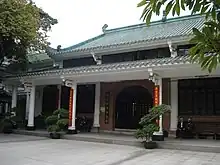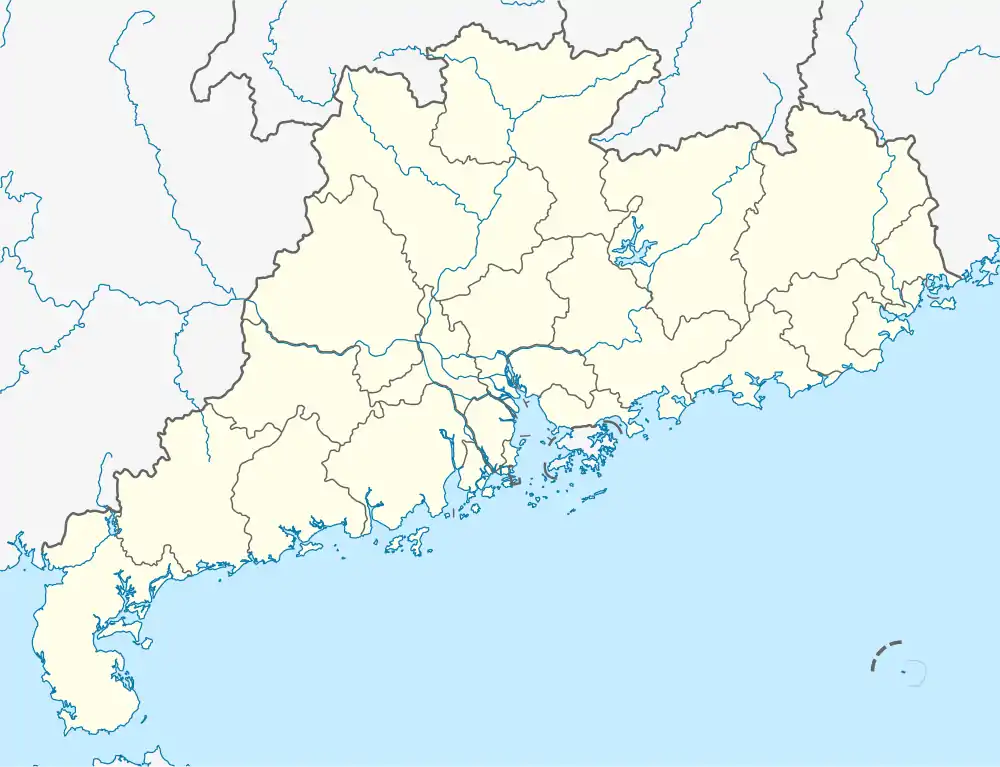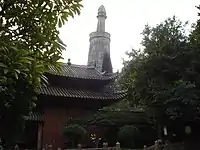| Huaisheng Mosque | |
|---|---|
怀圣寺 | |
 | |
| Religion | |
| Affiliation | Islam |
| Branch/tradition | Sunni |
| Location | |
| Location | Guangzhou, Guangdong, China |
 Guangdong | |
| Geographic coordinates | 23°7′31.38″N 113°15′12.91″E / 23.1253833°N 113.2535861°E |
| Architecture | |
| Type | mosque |
| Huaisheng Mosque | |||||||||||
|---|---|---|---|---|---|---|---|---|---|---|---|
| Simplified Chinese | 广州怀圣寺 | ||||||||||
| Traditional Chinese | 廣州懷聖寺 | ||||||||||
| |||||||||||
The Huaisheng Mosque[1][2][3] (Chinese: 广州怀圣寺;[2][4] also known as the Lighthouse Mosque[4][5] and the Great Mosque of Canton[n 1]) is the main mosque of Guangzhou. Rebuilt many times over its history, it is traditionally thought to have been originally built over 1,300 years ago,[6] which would make it one of the oldest mosques in the world.[7]
In China, the most unusual feature of the mosque is its pointed 36 metre minaret,[7] the Guangta or Kwangtah.[4] Although this meant the "Plain Pagoda" in reference to its unadorned surface,[8] it is also sometimes taken to mean "lighthouse" and gave the mosque its alternate name.[7] Somewhat similar "minimalist" minarets can be seen outside China, e.g. at the Khan's Mosque in Kasimov, Russia. The mosque was visited by Tim Severin's crew of the Sohar, that sailed into Canton from Muscat in July 1981, recreating the fictional voyage of Sinbad the Sailor.
History



Old Chinese Muslim manuscripts say the mosque was built in 627 by Sa'd ibn Abi Waqqas, a Companion of the Prophet who supposedly came on to China in the 620s.[9] Although modern secular scholars do not find any historical evidence that Sa'd ibn Abi Waqqas actually visited China,[10] they agree that the first Muslims must have arrived to China within the 7th century,[10] and that the major trade centers, such as Guangzhou, Quanzhou, and Yangzhou, probably already had their first mosques built during the Tang dynasty, even though no reliable sources attesting to their actual existence has been found so far.[9][n 2]
The minaret measures 36 meters in height and consists of two stories. It was the tallest building in the city until the beginning of the 20th century. In the Middle Ages, it served various functions, functioning as a lighthouse, a wind vane, and a control tower.[4]
It is very likely that the mosque existed during the early years of the Song dynasty. In 1349, Ramadan ibn Alauddin, the first named Korean Muslim, was buried in the mosque cemetery. The mosque was rebuilt in 1350 then again in 1695 after being destroyed in a fire. The Huaisheng Light Tower or minaret was built at an earlier period.[12] As late as the 19th century, the minaret tower was one of the major landmarks of Guangzhou.[8]
The Tatar traveler Abdurreshid Ibrahim who was an acquaintance of one of the Mosque's ahongs, Wang Kuan, was dismissive of the claim that this mosque was built by Sa'd ibn Abi Waqqas. He called it a peculiar idea:
This history is indisputable to the Chinese and it would seem to be impossible to persuade them that this was not the case ..... Sa’d bin Vakkâs was a famed person among the Noble Companions and the ten companions who were promised Paradise, and his biography is well known to Muslims. If Vakkâs had been an envoy [from the Arabs to China], the great Hadith scholars would have recorded it ... because some of them would have understood that anything that happened in the era of our Prophet Muhammad would have to be written down, without ignoring the slightest detail. If an envoy had been dispatched to China like this, Hadith scholars should have recorded it."[13]
Transportation
The mosque is accessible within walking distance south east of Ximenkou Station of Guangzhou Metro.
See also
Notes
- ↑ Other names and romanizations include the Hwai Sun Su Mosque, Huai-Sheng Mosque, Huai-Shang Mosque, Huai-Shang Si Mosque, and the Ying Tong Mosque.
- ↑ Lipman notes that, according to Leslie's detailed analysis of both Chinese and West Asian manuscripts,[11] the earliest reliable dates for mosque constructions in China pertain to the Song dynasty.[9]
References
- ↑ Kees Versteegh; Mushira Eid (2005). Encyclopedia of Arabic Language and Linguistics: A-Ed. Brill. pp. 379–. ISBN 978-90-04-14473-6.
- 1 2 Hagras, Hamada (2017). "An Ancient Mosque in Ningbo, China "Historical and Architectural Study"". Journal of Islamic Architecture. 4 (3): 102–113. doi:10.18860/jia.v4i3.3851.
- ↑ Hagras, Hamada (2019). "Xi'an Daxuexi Alley Mosque: Historical and Architectural Study". Egyptian Journal of Archaeological and Restoration Studies. 9 (1): 97–113. doi:10.21608/ejars.2019.38462.
- 1 2 3 4 Hagras, Hamada (2020). "The Functions and Symbolism of Chinese Minarets: A Case Study of the Huaisheng Guangta". Journal of Islamic Architecture. 6 (2): 68–76. doi:10.18860/jia.v6i2.10209.
- ↑ Yanxin, Cai (2011). Chinese Architecture. Cambridge University Press. p. 96. ISBN 978-0-521-18644-5.
- ↑ Great Mosque of Guangzhou Archived 2011-05-25 at the Wayback Machine at archnet.org
- 1 2 3 Steinhardt, Nancy Shatzman (September 2008), "China's Earliest Mosques", Journal of the Society of Architectural Historians, 67 (3): 335, doi:10.1525/jsah.2008.67.3.330
- 1 2 , 'Encyclopædia Britannica, 9th ed., Vol. V, New York: Charles Scribner's Sons, 1878, p. 37.
- 1 2 3 Lipman, Jonathan Neaman (1997). Familiar strangers: a history of Muslims in Northwest China. University of Washington Press. p. 29. ISBN 962-209-468-6.
- 1 2 Lipman 1997, p. 25.
- ↑ Leslie, Donald (1986), Islam in Traditional China: A Short History to 1800, Canberra College of Advanced Education, pp. 42–6, ISBN 9780858892736.
- ↑ "Great Mosque of Guangzhou". Archived from the original on 2005-02-19. Retrieved 2005-04-28.
- ↑ Yamazaki, Noriko (2014-07-03). "Abdürreşid İbrahim's journey to China: Muslim communities in the late Qing as seen by a Russian-Tatar intellectual". Central Asian Survey. 33 (3): 405–420. doi:10.1080/02634937.2014.953877. S2CID 144013422.